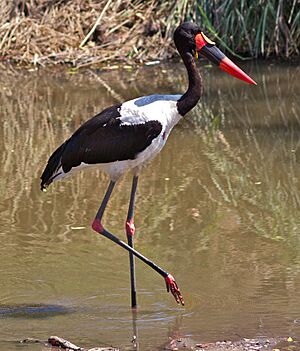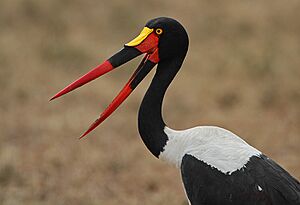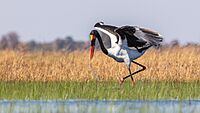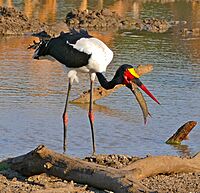Saddle-billed stork facts for kids
Quick facts for kids Saddle-billed stork |
|
|---|---|
 |
|
| Adult male in Kruger National Park, South Africa | |
 |
|
| Female in Masai Mara, Kenya – irises are yellow | |
| Conservation status | |
| Scientific classification | |
| Synonyms | |
|
Mycteria senegalensis Shaw, 1800 |
The saddle-billed stork (also called saddlebill) is a very large wading bird. Its scientific name is Ephippiorhynchus senegalensis. It belongs to the stork family, called Ciconiidae.
These amazing birds live in many parts of Africa. You can find them south of the Sahara Desert, from countries like Sudan and Ethiopia all the way down to South Africa. They also live in West African countries like The Gambia and Senegal. In South Africa, this stork is considered an endangered animal.
The saddle-billed stork is closely related to the black-necked stork. That stork lives in Asia and Australia. These two are the only members of their bird group, Ephippiorhynchus.
Contents
Meet the Saddle-billed Stork
This stork is a truly giant bird! It usually stands about 145 to 150 cm (4 ft 9 in to 4 ft 11 in) tall. That's taller than most people! Its wings can spread out to a huge 2.4 to 2.7 m (7 ft 10 in to 8 ft 10 in) wide. This makes it one of the tallest storks alive today.
Male saddle-billed storks are usually bigger and heavier than females. Males weigh between 5.1–7.52 kg (11.2–16.6 lb). Females are a bit lighter, weighing between 5 and 6.84 kg (11.0 and 15.1 lb).
You can easily tell male and female storks apart by their eyes. Females have bright golden yellow eyes. Males have brown eyes and yellow skin hanging from their face, called wattles. This is one of the few storks where males and females look different in color.
These storks have amazing colors! Their head, neck, back, wings, and tail are shiny black. The rest of their body and their main flight feathers are white. Young storks are more brownish-grey.
Their huge bill is red with a black band. It also has a yellow shield-like part on the front, which looks like a "saddle." Their legs and feet are black, with pink joints (called hocks). On their chest, they have a patch of bare red skin. This patch gets darker during the breeding season.
Stork Behavior and Habits
Saddle-billed storks are usually quiet birds. The only sound they make is a clattering noise with their bills when they are at their nest.
When they fly, they keep their neck stretched out straight. This is different from herons, which pull their necks back. Their large, heavy bill hangs down a bit below their body when they fly. This unique flying style makes them easy to spot, even from far away.
Where Saddle-billed Storks Live
Saddle-billed storks like to live in protected areas. These places often have lots of open water. You can find them in wetlands with forests and other flooded areas in warm, tropical regions.
Reproduction and Family Life
Saddle-billed storks build their nests alone. They create very large, deep nests out of sticks in trees. They often use the same nest year after year. Unlike many other storks, saddle-billed storks are often seen in pairs even when it's not breeding season. This suggests they stay together for life.
A female stork usually lays one to five white eggs, but most often two or three. Each egg weighs about 146 g (5.1 oz). The parents take turns sitting on the eggs for 30 to 35 days until they hatch. After hatching, the baby storks stay in the nest for another 70 to 100 days before they can fly. Young storks often stay with their parents until the next breeding season begins.
What Saddle-billed Storks Eat
Saddle-billed storks hunt for food in a few ways. They often stab their bill into the water, mud, or plants to catch prey by touch. They also hunt by looking for prey. One study found that most of their successful catches were from seeing the prey first.
They mostly eat water animals like fish, especially lungfish and catfish. They can even swallow fish weighing up to 1.3 kg (2.9 lb)! They swallow fish head first and then drink some water. If a fish is very large, they might take it to the shore. They sometimes even clip off the fish's fins before swallowing it.
These storks also eat other animals when they get the chance. This includes frogs, snails, small mammals, birds, snakes, and insects like grasshoppers. There was even a rare report of a saddle-billed stork killing and eating a red-billed Duck and a spitting cobra.
Saddle-billed Stork in Ancient Egypt
This bird was very important in Ancient Egypt. It was shown in an Egyptian hieroglyph (a picture symbol) that had the sound "bꜣ":
|
|
Sometimes, people mistakenly say this hieroglyph shows a "jabiru". But the jabiru is a different stork that lives in South America.
The pharaoh Khaba, who ruled during the Third Dynasty of Egypt, even used this hieroglyph in his name. The first pictures of saddle-billed storks in Egypt appeared a very long time ago, before 3150 B.C. These old pictures help us understand that the storks used to live in more parts of Egypt. But as cities grew and the climate became drier, their numbers likely went down.







